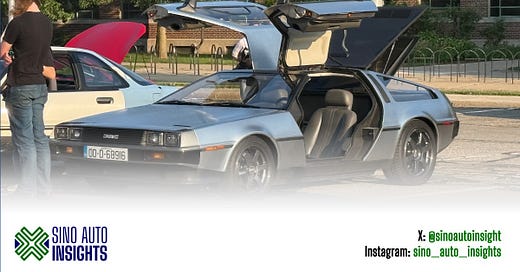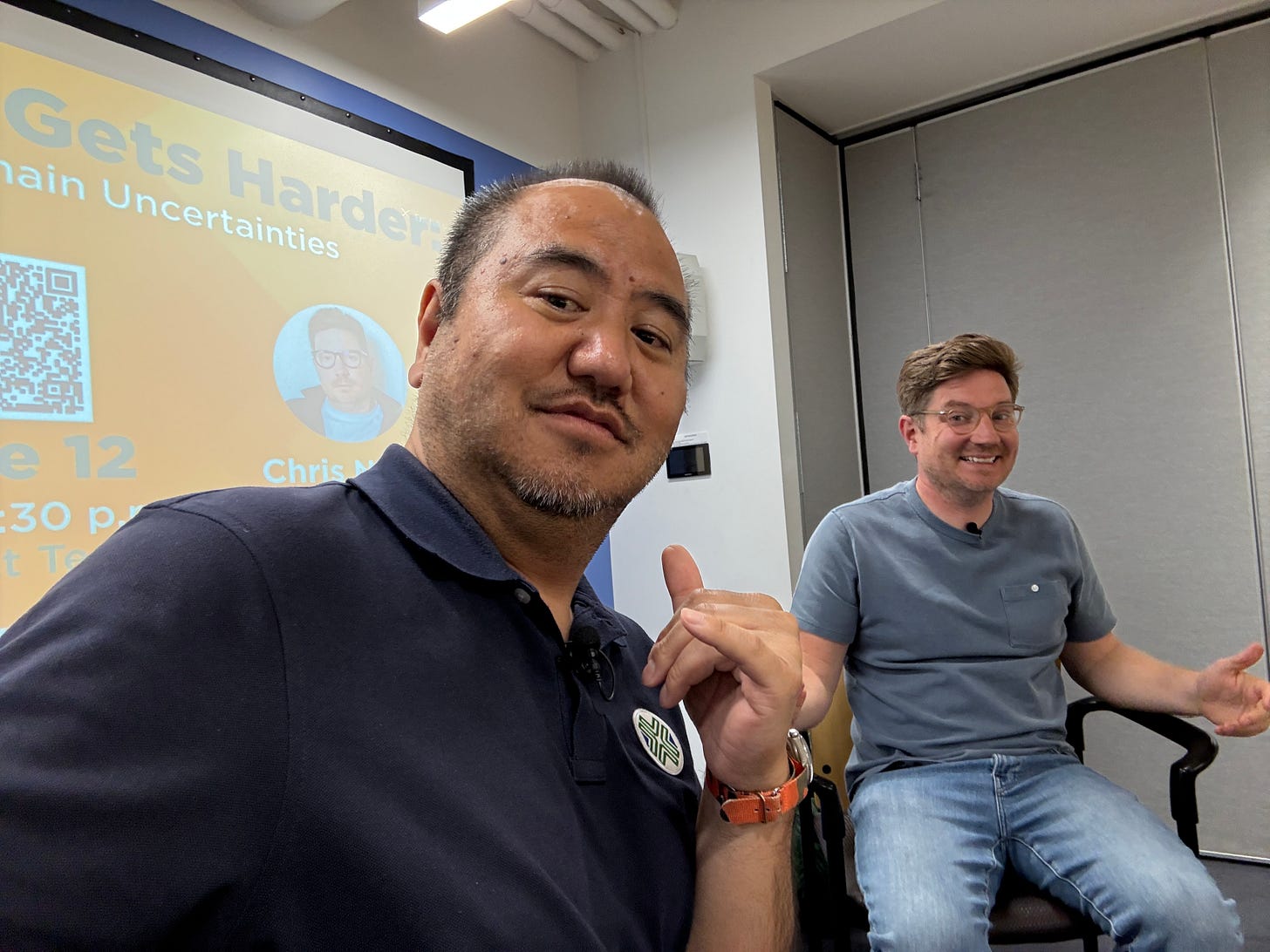SAI Weekly 20 - 25: GM: One Step Forward $4B Backwards, Livestream with Bill Bishop, Nvidia Worried About Its Future in China
Was in East Lansing this week for my son’s Michigan State basketball camp. He seemed to have had a ton of fun despite working pretty hard – this wasn’t some fluff camp, he’s getting a lot of court time and he enjoys his teammates. The best part – Tom Izzo and his team are leading the way. They’ve all been very accessible and a big part of the experience for the kids. Made me like Izzo even that much more.
I also juggled a few events this week, highlighted by last night’s – Hard Tech Gets Harder - discussion with co-founder of Bloom, Chris Nolte. This event was aimed directly at hard tech entrepreneurs who find it nearly impossible to build products , and make any firm commitments for the future with regards to sourcing and component & logistics cots, similar to their much larger Fortune 500 CEOs.
Lot’s talked about – I pulled from my prior life as a supply chain / sourcing guy to talk about my experiences and how we responded to changes and uncertainty in the markets.
___
One other BIG highlight was being able to do a Substack Livestream with 老北京朋友 – Bill Bishop. For those that aren’t familiar, Bill is one of the co-founders of Marketwatch, but I met him while in Beijing a long time ago. Most people nowadays know Bill as one of the most knowledgeable people on the planet about China.
He had me on his podcast two years ago and both decided that had been long enough. Below is our discussion talking all things China EV Inc in and outside of China. Don’t miss this one!
AI for good. Meaning for good entertainment – this has been flying around the interwebs so I had to share it for those that haven’t seen it yet.
Finally, was this Jim Farley’s Xiaomi SU7? It was parked in front of Michigan Central - the old, but newly rehabb’d Detroit Train station in the Corktown area. I am still trying to figure out what event this was for, but someone sent me the photo asking if I was there. Alas, I was in EL, but am definitely wondering why it was parked for Ford employees to oogle over. Props to Vik Moshan for sending me over this snap.
CHINA EVs & MORE
Just dropped! Our special part #1 (of two) AutoShanghai2025 Roundtable with Jill Shen (Technode), Ethan Robertson (Wheelsboy) and Ed White (FT) has been posted on YouTube and for our audio listeners, on most podcast platforms. The recording isn’t perfect so many apologies for some of the video and audio quality, but content wise I think it’s some of the best we’ve done. Great discussion amongst local 上海人 – DO NOT MISS THIS ONE!
BIGGEST NEWS THIS WEEK
Bank of America (BofA) Car Wars makes its way to Detroit. This is an annual report from BofA and I missed this year’s presentation, but wanted to opine on a few things that John Murphy, the lead autos analyst for BofA, predicts.
First off – he wades into what’s going on in China and emphasizes EVs which can be a pretty dangerous thing if you’re not careful and detailed on how you attack and explain things. The immediate risk of huge overcapacity in China is on the ICE side not the EV side, since demand for them over just the last few years have fallen off a cliff. I’ve not heard of m(any) major factories closing on the ICE side so let’s make sure we specify in more detail what’s happening without pulling out that broad brush.
Next – He predicts that there will be consolidation due to the battering companies are taking because ongoing price war. First, consolidation has been something analysts have been predicting for literally YEARS in China, even before I made my way there in 2009. Does this time feel different, a bit but what’s important here is that it always seems like they make these statements based on a combination of their understanding & historicals of the US / EU automotive world.
China is unprecedented in world economic history. They boast 1.4B people so their tolerances for moving into ‘involution’ and a total ‘collapse’ are much, much different than the US and EU. Is that ever taken into consideration when they make predictions about China? I am pretty good at math, but theses guys work with data and numbers ALL DAY, so they have to be better at forecasting and predicting, right? That said, it’s never clear why THIS time its different (vs. before) when they make such bold predictions about China.
Remember, John Elkann predicted that this year, the China market would outsell the US and EU markets combined. If that happens, that’ll be the first time in history that it’ll have happened, so let’s acknowledge that of the guesses you make each day, there’s precedent for a lot of them, just not in the case of China. If you still stand by your predictions, what’s the China multiplier/divider you’re using? How’d you come up with that multiplier? Many analysts are selling clicks or reports so the bolder the better - either in the forecast or the claim.
Finally, the legacy automakers having writedowns for their EV ambitions? That was predictable the moment they made their ambitious claims about how fast they could sell the first 1M EVs in the US market and then backed that up with the large amounts of capital they planned to invest to make that happen.
Those rosy projections from Ford, GM, Stellantis were never going to happen – FULL STOP. The people that allowed Mary, Jim and at the time, the US leadership of Stellantis to make those bold, but (very unrealistic) claims should have been fired. Or they should now. Speaking of growing EV adoption…
___
GM is #2 in the US, so retreating is the right thing to do, right? Through the first 5 months of the year, GM has clawed it’s way to 2nd place in the US market. But rather than lean into that momentum, GM has decided it wants to move backwards into selling more BIG, ICE SUVs with a their announcement of investing $4B in Orion and a few other facilities.
If I were Kurt Kelty, I wouldn’t be very happy with this. First of all (see earlier post), who told Mary to say GM would sell 1M EVs by 2026?? Next, the Ultium fiasco played a decent role in delaying EV product rollout as well. Now we are blaming subsidies for China’s advantage in the EV space and doubling down on ICE while slowing down EV rollout? Headscratcher. How does this make you MORE competitive outside the US market? What other countries buy Tahoes and Silverados?
Even without China, GM (and Ford for that matter) should thank their lucky stars Tesla (well, Elon anyways) decided to focus on a vanity project called the Cybertruck rather than roll out a $35K Model 2. One that in my humble opinion would’ve killed in the market and pushed EV adoption much, much higher even without massive subsidies.
Here’s the rub, if Elon can stay out of politics and launch a smartly designed and cheaply priced Model 2 in the next year – Tesla could STILL drop another bomb into the US market. That’s actually what I kinda hope happens, because that seems like the only way the US Three will take building high quality, innovative yet affordable clean energy vehicles seriously – because they’ll be forced to. I still hold out SOME hope that the baby Gravity and R2 come in undercutting the market next year, but that seems less and less as each day passes by.
___
UAVs are a key area that needs to be reshored. The other part of what I do as some of you may know is that I help the innovation ecosystem in Detroit and in Michigan, mentor entrepreneurs in the mobility space and more and more I’ve had meaningful convos with the investment community so that they better understand what is happening outside of the US and how some of it can rub off on the US. One thing that’s notable recently is what Ukraine was able to do to Russia by building their own UAVs and transporting them behind enemy lines undetected.
I’ve met with MANY UAV (read: drone) companies all over the world, but one thing that’s always been a bit of a red flag for me is their reliance on China to help them build, well everything. Not so for one company that’s been highlighted in the linked Fast Company article.
One of the front runners for best UAV startup in the US has to be Zipline. They are called Zipline because they design AND manufacture drones to deliver goods to businesses and people. Either parachuting the product to the delivery point or ‘ziplining’ it down to them. They are based in Silicon Valley, but have made deliveries all over the world. Love what they’re trying to do and respect that they want to vertically integrate and bring most things ‘in-house’ since that seems like a prudent decision nowadays.
Always remember that progress is being made. If we want to have our companies compete globally, they’ll need a push from both local and federal governments as well as private investors and partners that give their tech a shot. That’s how we get ourselves back into this game.
Just a reminder of what’s happening outside the US – here is a video I took a year ago of a Meituan drone delivering KFC to a park in Shenzhen. You can order from the kiosk that the food will be delivered to. Yep, that’s happening.
___
No wonder why Nvidia and ASML want the US to lift restrictions. Friend of SAI, Ed White who also happened to be a roundtable guest this week interviewed He Xiaopeng and wrote about it here. In the article, He Xiaopeng details the investment that XPeng has made in designing their own silicon to train their AI models as well as help their vehicles on the intelligent driving side. That has to scare Jensen Huang in a big way since XPeng is one of MANY Chinese tech and EV companies that are working on designing their own silicon.
In XPeng and NIO’s case, they have communicated that the self designed chips they will use in their products are using 5nm technology, not the bleeding edge, with is currently 3nm, but is tremendous progress for companies that have only recently begun building out this competency. The challenge is that it’s VERY capital intensive so how will they pay for the investments? Sell their silicon to other automakers, which till now Nvidia has had the first right of refusal on, at least with the OEMs that are offering L2+ intelligent driving.
This first means that Nvidia will need to cut pricing in order to stay competitive, but longer term, they’ll need to still be much better than their competitors if they’re going to continue to sell to them.
_________________
This weekly newsletter is a collection of articles we feel best reflect the happenings of the week or important trends that have effects on the global automotive and mobility sectors. We also provide a point of view that we hope educates and sparks debate.
The Sino Auto Insights team








